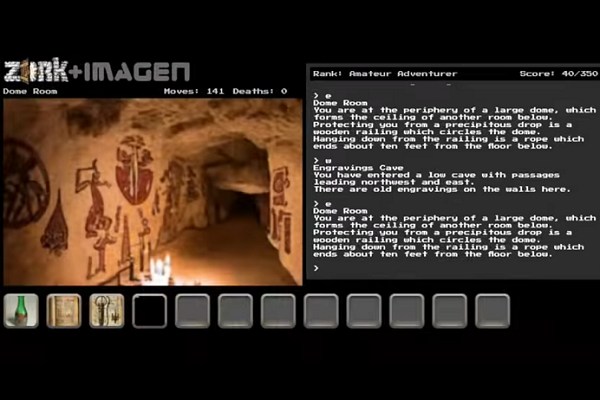Google Text-to-Image AI Imagen Adds Graphics to 70s Text Adventure Game Zork
Classic 1970s text adventure Zork has some graphics thanks to Google’s Imagen text-to-image AI tool. The interactive fiction from 1977 has been augmented with visuals thanks to Google principal engineer Matt Walsh and his team, as seen in the video above.
Zork Visualized
“Some adventure game fans at Google wondered what would happen if you used the output from the classic text adventure game “Zork” as the input to Imagen, Google’s text-to-image diffusion model,” Walsh explained for the video. “To support the results we wanted We made some additions to Zork itself, which was a fascinating journey through an arcane language and a lost (but re-engineered) toolchain.”
Google first unveiled Imagen and its text-to-video capabilities in October before sending it to its AI Test Kitchen. The generative AI tool translates words into images and videos through a process involving seven diffusion models to first produce a low-resolution video draft before upgrading the resolution repeatedly. The process is applied to Zork by using the descriptions in the game as prompts for Imagen. To make it work, the group also applied Google’s LAMDA AI to compress the information so that Imagen could process the data and remember it so that returning to a location wouldn’t produce an entirely new image. The same technique allowed the AI to visualize the player’s inventory as well.
Notably, Imagen’s ability to process text into images in different styles meant that Zork could be played with different kinds of visuals. The images could be rendered as pencil drawings, mosaics, or Rembrandt, as the video demonstrates. Zork, an old term for an unfinished program, can look a lot more finished, thanks to generative AI.
“This is an example of the potential of these types of generative AI integrations, but also the limitations,” Voicebot and Synthedia founder Bret Kinsella pointed out. “It is also not clear that any game maker would allow this much randomness into their game, but it certainly could be used in the creative process.”
Generative AI Gaming
This isn’t the first application of generative AI to video games. Game developer Latitude created AI Dungeon to use advanced language models to produce the text of the game and interact with players through its characters. The game currently uses the Jurassic-1 model created by AI21 Labs to run a text adventure game like Zork, except there is no script. Instead, it employs a template that the AI builds on to tell a new adventure for every player, one that adapts to player choices It’s also capable of generating images of the player’s character by feeding the player’s text description into a visual model styled after the pixel images of the 1980s.
The Zork project demonstrates some of what Google’s Imagen technology is capable of, which Walsh said is largely the purpose. However, he and his team have future ambitions for more text games, including Zork 2, and he wants people to be inspired by the Zork project to pursue their own ideas for generative AI.
“Our project plays the entire original version of Zork with all the puzzles Loot and countless ways to die that you remember,” Walsh said. “Beyond playing these masterpieces in a new way, we hope our project gives a fun way to stimulate ideas in the generative imagery field.”
Follow @voicebotaiFollow @erichschwartz
AI Dungeon’s Synthetic Story and Pictures Released on Steam Gaming Platform
Google Debuts Imagen Video AI Text-to-Video Generator Rival for Meta’s Make-A-Video
Google Sends Imagen Text-to-Image Generator to AI Test Kitchen









